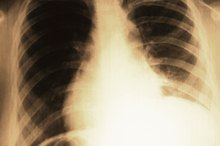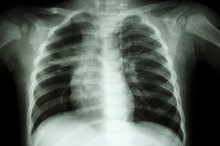What Is the Treatment for a Punctured Lung?
Trauma from a gunshot or knife wound, or high force blunt trauma like a car accident, can all lead to a punctured lung. A lung may also be unintentionally punctured when a doctor is attempting to insert an intravenous line into a large blood vessel in the chest or neck. When the lung is punctured, air typically collects in the pleural space located between the lung and chest wall. The collection of air -- called a pneumothorax -- presses on the lung, preventing it from expanding normally when the person breathes in 3. This can produce shortness of breath. When large, a pneumothorax may cause total collapse of the lung and compress the heart and blood vessels in the chest 3. This is a life threatening condition that requires immediate treatment. Overall, the treatment of a punctured lung depends upon the size of the injury and pneumothorax, as well as the body’s response to the injury 3. Anyone with a possible or obvious punctured lung should seek prompt medical attention.
If you are experiencing serious medical symptoms, seek emergency treatment immediately.
Oxygen
People with a punctured lung will typically go directly to the emergency room or be seen by emergency medical service personnel at the scene of the injury. As a punctured lung usually causes shortness of breath, the initial treatment is generally oxygen by a face mask. Breathing oxygen will help increase the amount of oxygen that enters the blood and eventually reaches the body’s cells. Oxygen treatment can also help air within the pleural space be absorbed into the blood vessels lining the space. This may decrease the size of the pneumothorax 3.
- People with a punctured lung will typically go directly to the emergency room or be seen by emergency medical service personnel at the scene of the injury.
- As a punctured lung usually causes shortness of breath, the initial treatment is generally oxygen by a face mask.
Coverage
Atelectasis Vs. Scarring
Learn More
Open wounds in the chest are generally covered by a bandage to prevent the entry of bacteria. Sometimes a large wound that penetrates the lungs will cause a sucking chest wound, in which air is pulled in through the wound every time the person attempts to breathe. If this is present, medical professionals typically place a special bandage containing petroleum jelly on the wound to create a seal. The bandage may be taped on only three sides so air can escape from the wound but not re-enter it.
- Open wounds in the chest are generally covered by a bandage to prevent the entry of bacteria.
- Sometimes a large wound that penetrates the lungs will cause a sucking chest wound, in which air is pulled in through the wound every time the person attempts to breathe.
Wait and See
If the puncture wound is small, your doctor may choose a "wait and see" approach. A small area of punctured lung may be able to heal on its own. But it is important to let your doctor decide whether this is the right approach. Do not make the decision to "wait and see" on your own, as delay in treating a punctured lung can lead to complications. These may include the punctured lung failing to heal or the lung not re-expanding to its normal size, even if healing occurs. Infection of the lung or pleural space may also occur without proper medical care.
- If the puncture wound is small, your doctor may choose a "wait and see" approach.
- These may include the punctured lung failing to heal or the lung not re-expanding to its normal size, even if healing occurs.
Needle Aspiration and Chest Tube Insertion
Collapsed Lung Exercises
Learn More
If a pneumothorax is large or causes significant shortness of breath, a narrow needle may be inserted between the ribs into the pleural space 3. The needle is attached to a syringe, which is then used to remove -- or aspirate -- the air from this space. If this does not remove enough air, a chest tube may be placed into the pleural space. The tube is also inserted between the ribs, but it is wider than the needle. The chest tube is generally attached to a suction device that continues to remove air over the course of several hours or days.
- If a pneumothorax is large or causes significant shortness of breath, a narrow needle may be inserted between the ribs into the pleural space 3.
- If this does not remove enough air, a chest tube may be placed into the pleural space.
Surgery
A large puncture wound may require surgery, as the lung tissue may not be able to heal itself, leading to continued leak of air and a persistent pneumothorax 3. In some instances, the punctured lung is repaired by video-assisted thoracoscopic surgery (VATS), in which the surgeon uses a tiny camera and instruments placed through a series of small incisions in the chest. In other instances, the surgeon will use a traditional, open surgery approach, repairing the lung through a single, larger incision. At the end of either type of surgery, the surgeon may leave a chest tube in place to remove excess air and any blood or other fluids that may be present in the pleural space.
Reviewed by: Mary D. Daley, MD
- A large puncture wound may require surgery, as the lung tissue may not be able to heal itself, leading to continued leak of air and a persistent pneumothorax 3, in which the surgeon uses a tiny camera and instruments placed through a series of small incisions in the chest.
Related Articles
References
- Interactive Cardiovascular and Thoracic Surgery: Three-Step Management of Pneumothorax -- Time for a Re-Think on Initial Management
- Journal of Zhejiang University Science B: Diagnosis and Treatment of Primary Spontaneous Pneumothorax
- Merck Manual: Pneumothorax
- Genetics Home Reference. Available at: https://ghr.nlm.nih.gov/condition/primary-spontaneous-pneumothorax#statistics. Accessed November 15, 2019].
- Cleveland Clinic. Collapsed lung (pneumothorax). December 1, 2013.
- Zarogoulidis P, Kioumis I, Pitsiou G, et al. Pneumothorax: from definition to diagnosis and treatment. J Thorac Dis. 2014;6(Suppl 4):S372-6. doi:10.3978/j.issn.2072-1439.2014.09.24
- Noppen M, Verbanck S, Harvey J, et al. Music: a new cause of primary spontaneous pneumothorax. Thorax. 2004;59(8):722-4. doi:10.1136/thx.2003.007385
- Genetics Home Reference. Available at: Accessed November 15, 2019].
- Sajadi-Ernazarova KR, Martin J, Gupta N. Acute pneumothorax evaluation and treatment. Treasure Island, FL: StatPearls Publishing. August 12, 2019.
- Scott RM, Henske EP, Raby B, Boone PM, Rusk RA, Marciniak SJ. Familial pneumothorax: towards precision medicine. Thorax. 2018;73(3):270-276. doi:10.1136/thoraxjnl-2017-211169
- Tulay CM, Özsoy IE. Spontaneous Pneumothorax Recurrence and Surgery. Indian J Surg. 2015;77(Suppl 2):463-5. doi:10.1007/s12262-013-0876-6
Writer Bio
Dr. Franchesca Vermillion is based in Portland, Ore. and has been writing health-related material for her patients and for public speaking events for more than four years. Vermillion obtained her Bachelor of Arts in molecular biology from the University of Denver in 2001 and her Chiropractic Physician's Degree from University of Western States in 2006.








